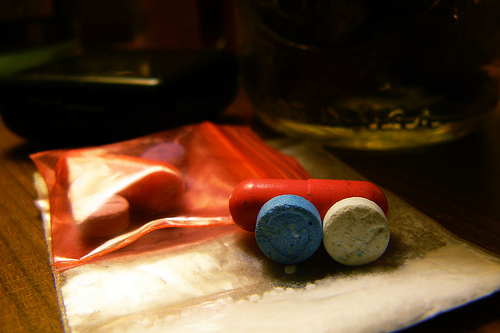Have you met Molly?

By: Michelle Vu
Referenced in the popular music of artists such as Miley Cyrus and Kanye West, “dancing with Molly” and “popping a Molly” has become proliferate in the rave scene in the past decade. However, Molly is not chemically a new drug but is the reincarnated form of MDMA of this era. Now sporting a pure, innocuous name, Molly – also known as “E,” “XTC,” “X,” “Adam,” “hug,” “beans,” “clarity,” “lover’s speed,” and “love drug”- has the reputation of being a harmless, fun and non-hardcore drug. Accordingly, the demographic of Molly users consists of first-time drug abusers between the ages of 12 and 17 and older professionals in their 30’s and 40’s. However, as typical of pop culture drugs, the hype about Molly is often independent of the drug’s chemical facts.
Molly is a powder or crystalline form of MDMA—3,4-methylenedioxy-N-methylamphetamine—the active ingredient in ecstasy. Like many active ingredients in street drugs, MDMA has medical benefits. Patented by Merck pharmaceuticals, MDMA was used to treat depression. Here is how MDMA works: about 45 minutes after ingestion of a pill, MDMA is at peak drug levels in the bloodstream. Though promoting the release of feel-good hormones, including oxytocin, norepinephrine and serotonin, MDMA induces a “high” of euphoria, intimacy, and inhibited zeal, perfect for drug users who want to make close dancing companions at raves. A “hit” of MDMA lasts for 3 to 6 hours, and is accompanied by withdrawal effects, which include teeth grinding, dehydration, anxiety, insomnia, fever and loss of appetite. However, unlike the known chemical and subjective effects of MDMA, the effects of taking a pill branded as Molly are unpredictable.
Though by definition Molly is pure MDMA, this drug has transformed into a toxic mixture of novel synthesized drugs. The increased demand for the drug has resulted in its decreased quality. As noted by a CNN report, “3% of the Molly seized in New York state the last four years actually contained any MDMA, and often contained a variety of designer stimulants and hallucinogens.” Due to the unknown effects of these synthetic mixtures, Santos from CNN remarked “You’re playing Russian roulette if you take these compounds.”
The majority of these synthesized compounds originate in China, where different drug regulations permit scientists sell their newest drug concoctions online. These drugs enter the U.S. via middlemen and into the hands of buyers, usually teenagers. Even within the U.S., “Breaking Bad” scientists experiment with compounds to produce those with recreationally viable effects. This market is an illegal, multibillion-dollar business and a major problem to law enforcement.
In July of 2012 as an effort to monitor “Molly”, Congress passed the Synthetic Drug Abuse Prevention Act, which controlled 26 identified compounds. Yet, a major barrier in slowing the distribution of Molly is that the U.S. cannot regulate the rapid production of novel synthetic drugs. This is because known illegal compounds are easily modified, and the Drug Enforcement Agency (DEA) cannot identify and ban the new compound quickly enough. Meanwhile, the Molly sold not only induces head banging fun but also claims lives.
To assess how dangerous Molly is, it is better to consult medical knowledge over popular perception. According to a NY Times article, “pure MDMA rarely leads to death when taken alone. However, the often accompanying lab-synthesized chemicals come with a variety of side effects: rapid heartbeat, sweating, panic attacks, psychosis and seizures.” In fact, the Drug Abuse Warning Network’s study found that from 2004 to 2009, there was a 123% increase in the number of emergency room visits involving MDMA taken alone or in combination with pharmaceuticals, alcohol or both. Clearly, these side-effects do not match Molly’s harmless connotation.
The dominance of drug perception over drug fact in determining drug use, both legal and illegal, demonstrates that societal factors have a strong influence in medicine. For example, Adderall, a treatment for Attention Deficiency Disorder (ADD), was once touted as an integral tool for making students learn faster and get smarter, even though most of the medical community was skeptical about its benefits. Likewise, Molly’s reputation as a “fun drug” for all demographics that allows you to befriend all on the dance floor should be qualified with the fact that Molly can leave you alone, in a less than ideal state.

